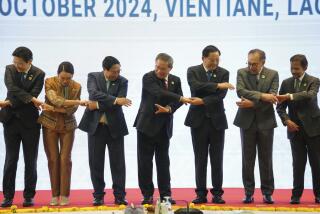High Tech’s Leaders Undeterred by Turmoil in Asia
- Share via
SAN FRANCISCO — Aiming to give some perspective to Southeast Asia’s economic crisis, Andrew Grove kicked off a technology summit here last week by harking back to the region’s past.
The Intel Corp. chief executive showed a picture of himself taken 27 years earlier, his pants rolled up to his knees, wading through mud that kept his car from reaching the site of a new plant being built in Malaysia.
“Just to finish the story,” Grove said, “it’s a place where we employ over 8,000 people today.”
The tale symbolizes the high-tech industry’s dedication to Asia, even in the midst of an economic collapse that has driven currency and stock market values down as much as 40% in some countries.
Dozens of top technology executives and high-ranking trade representatives who attended the Asia-Pacific Information Technology Summit said they are dismayed but undeterred by the financial turmoil roiling the region.
The reason is simple: Each side of this economic equation believes it can’t do without the other over the long term, no matter how turbulent the relationship is in the short term.
“Today, the right side of the Pacific has 10 times as many computers as the left side,” said Stan Shih, chief executive of Acer Group, a giant computer maker based in Taiwan. “But the left side has 10 times as many people.”
The implication that these figures are destined to move toward a balance was one that most participants at the two-day conference seemed to take for granted.
The gathering was planned long before the recent economic chaos erupted, and most speakers and panelists preferred to address the issue only in passing, if at all.
But in informal discussions, lunchtime conversations and press interviews, most participants said they are still trying to sort out the impact of recent steep declines of many Asian currencies in relation to the dollar.
For many, the fallout is mixed.
“The crisis has certainly not been a help to PC consumption or our business,” Grove said. “But every PC is like a technological United Nations, with parts coming from all over the world.”
That means that while sales into Asia are slowing, components from the region are cheaper, and the costs of building and running factories there--as most big technology companies do--are lower. “How this will all wash out I don’t know,” Grove said.
At Oracle Corp., the world’s second-largest software company, sales growth in Asia has dropped to 30% this year from 60% last year, said Chief Executive Larry Ellison.
“But our growth rate in France two years ago went to zero,” Ellison said. “Asia on a whole is doing very well.”
Cisco Systems Inc., a giant maker of computer-networking equipment, has seen sales in Asia slip from 16% of the company’s overall revenue to 12% over the last year, said Chief Executive John Chambers. But in the long term, that percentage is expected to climb significantly.
“We’re very patient,” he said, adding that Cisco might temporarily rein in sales efforts in the most troubled economies, such as South Korea, which last week sought an international bailout.
Asian government officials went to great lengths to offer reassurance, although some acknowledged that there will be sacrifices.
Malaysia, for instance, halted work on a number of government projects, including a hydropower plant and a new airport. But spending on a massive high-tech enclave called the Multimedia Super Corridor, stretching from Kuala Lumpur to a recently completed airport 30 miles away, will not be interrupted.
The project, an effort to attract foreign investment by high-tech companies, is regarded as a top priority, said Leo Moggie, minister of energy, telecommunications and posts.
Companies that build in the corridor will be lavished with unprecedented privileges, including tax breaks, freedom from import duties on equipment and an unrestricted ability to bring in high-tech workers.
“The opportunity [for foreign investors] is probably better now” because the currency crisis makes the dollar stronger, Moggie said.
But it hardly benefits the Malaysian people. “We’re about 30% poorer,” he said. “The costs [of the crisis] are quite extensive.”
Moggie and many others said the countries of Southeast Asia will emerge from the crisis at different speeds, with Taiwan and the Philippines poised to recover more quickly, perhaps within a few years, while others--including South Korea and Thailand--could take significantly longer.
Acer Group, based in Taiwan, could see its profit margins widen in export markets, Shih said. The companies that will suffer, he contended, are less established firms that will find the hunt for capital harder now that banks are hurting and stock markets are in decline.
Grove, in his speech, made the somewhat self-serving argument that Asian economies need to redouble their investments in information technologies to become more competitive and pull themselves from the present slump. But as many Southeast Asian leaders have learned in recent months, technology is a mixed blessing.
“Can technology be a tool for regional growth? I say yes without hesitation,” said Fidel Ramos, president of the Philippines. “But we have experienced rather painfully the quickness with which global technology can move investments into, and out of, portfolios.”
*
* ECONOMIC SUMMIT
Clinton told Pacific Rim leaders he expects Congress will grant him “fast-track” trade authority. A1






